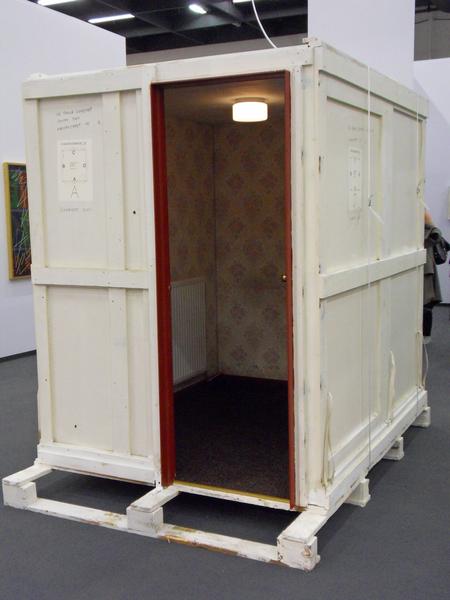You have no items in your cart. Want to get some nice things?
Go shopping
Doors abound at Frieze Art Fair. The labyrinthine structure is riddled with them: doors dividing the tent from the park and the VIPs from the general public. Even within the stands themselves doors recur – twisted in tight circles, as in Alicja Kwade’s Eine Tür ist ein Raum (eadem mutata resurgo est), smudged over with dark charcoal forms in the Modern Institute of Glasgow, frequently warped into amorphous shapes.
“I get the willies when I see closed doors,” Joseph Heller once wrote, and Graciela Carnevale, whose work is being exhibited as part of Frieze Masters, would give him good reason for this alarm. A member of the Grupo de Arte de Vanguardia de Rosario in Argentina in the 1960s, Carnevale’s work was political in intention and often violently realised. In her infamous piece El Encierro (The Enclosure), she hermetically sealed a group of unwitting visitors in an empty room for several hours; coerced into participation, their responses became the art under observation.
Thankfully for the claustrophobics among us, no such stunt was pulled at Frieze, although it was interesting to observe a recurring theme of confinement in several galleries. Self-contained spaces within the parameters of a stand were popular, I noticed, a tool to isolate the viewer and impress upon them an alternative reality. The MOT International stand contained a candy-pink carpeted booth entitled Grandma’s Dream, in which ran a video of a fictional grandmother’s ideal world (in Grandma’s dream there is a “big teapot… serving tea from the sky”, it informs in saccharine tones). Both the Konrad Fischer Gallery – with Gregor Schneider’s Nursery (Walden Street No. 14, London) , 2004- and Vitamin Creative Space play host to contained areas of their own.
A short walk across Regent’s Park delivers me to the Snowdon Aviary, in which a colourful diversity of birds struggle against their confines. The cage’s striking shape is of artistic interest (much like the smooth modernist lines of Berthold Lubetkin’s nearby penguin pool), and it is said to have been one of the first places conceptual artist Cerith Wyn Evans visited when he moved to London in the 1970s.
Against the white of the London sky, the pale lettering of Wyn Evans’ installation is difficult to determine. Stretched between the bank and the aviary, it reads: So, I came to know what the Japanese puppets taught us, namely, what it is to be moved. The dual understanding of “moved” is fitting here. Its second interpretation – of physical movement – is well-suited to its location, along the busy stretch of pavement beside the canal and attached to the agitated hive of energy that is the aviary. Frieze itself is a place of similarly incessant movement – for, despite all the doors, there are no limitations. Its industry does not seem to cease. Nick Mauss’s ballet, which, through lack of doors, makes no distinction between stage and backstage, becomes a constant, fluid hub of action. Meanwhile, Adam Linder’s dance piece is performed uncountable times, children play with tireless energy among the neon stand of the kindergarten-themed Gargosian Gallery, Sophia Al Maria’s television set guides visitors through the fair over and over again, and the great crush of people continuously comes and goes.
I walk away from all of this movement for the last time, reminded of the moment when Alice leaves the tea party in Wonderland. The scene before me shares the surrealism of Carroll’s fiction, with children swinging on a giant mushroom while a pair of women in vivid petticoats look on. “That’s very curious,” Alice thinks. “But everything’s curious today. I think I may as well go at once.” So she passes through a nearby door and escapes the strange Mad Hatterishness of the scene. And, exhausted by the energy of a place which is never still, I turn to do the same.

About Xenobe Purvis
Xenobe is a writer and a literary research assistant. Her work has appeared in the Telegraph, City AM, Asian Art Newspaper and So it Goes Magazine, and her first novel is represented by Peters Fraser & Dunlop. She and her sister curate an art and culture website with a Japanese focus: nomikomu.com.




